Once upon a far away time, when superhero comics had just begun, comics were 64 pages long and cost a dime.
Came the war and with it paper restrictions. Ended the war and with it expanding bureaucracy in government and businesses and with it, increases in the price of paper. Comic books got shorter and shorter until, in Challengers of the Unknown, the whole comic was taken up with one story for the first time ever.
Still not enough, comics rose in price from 10¢ to 12¢ and met great customer backlash. It was suddenly unusual for an issue to sell a million copies. Before and during the war such circulation had been common.
There had to be a way to boost income for the company. The people working in the comic book industry looked upon declining income and said unto themselves, “You getting a drink after work?”
DC reminded themselves they bought stories and art outright. If they could publish it twice, it would be an extra profit. It’s not like they had to pay royalties or anything, or give back the original art. So in 1964 they took a look at their backlog and picked out a few with an eye to careful market analysis and a strong forward plan of market integration.

Nearly everything DC does, except animation, it seems to do unconsciously: without for, during, or afterthought
Or they just picked out a bunch of Superman imaginary stories of lives Superman could have had. From there, they kept going with new themes and spread to Batman, Flash, the Justice League, Jimmy Olsen, Lois Lane, and so on. I personally remember the kryptonite-themed issue – whatever happened to Jewel kryptonite?
They had some good issues. And they got better at presenting them over time. But the page count dropped from 80 to 64 because the price of paper was still going up and, with it, the price of comics. The series stopped in 1971 but other versions came out after introducing original material in their reprint books.
“Getting a drink after work?”
“No, one is never enough.”
And more recently they figured out how to not have to pick stories.
“How do you do that?”
“We just publish everything in hardcovers in order.”
The ultimate anthology for those who have the dedication and the money. But in the seventies a different path was taken.
Marvel got hold of the idea and decided, if DC could make a buck out of this, maybe Marvel could make two. Until the era of the MCU, DC always had more money than Marvel even when Marvel wasn’t bankrupt. The House of Ideas often let DC do the market research.
So Marvel started in 1974 with the first Treasury edition containing seven Spider-Man stories. Two years earlier, DC had rebooted the idea with Rudolph, the Red-Nosed Reindeer.
So Marvel was inclined to take an idea and try to add something to it. Treasury editions were reprint anthologies. Like DC, they owned the material and had been putting together reprint titles. It is likely more people know the origin of Daredevil from his anthology reprint than the origin issue, which apparently didn’t sell that well. Reprints had impact and scooped up extra money for the original outlay.
Marvel’s Treasury Edition is 10”x14”, which is larger than the normal comic book and is called tabloid magazine or treasury sized. Marvel produced between 2 and 5 such editions a year between 1974 and 1980, both 1974 and 1975 being years with 5 titles each. Unlike DC, which always concentrated on Superman and Batman, Marvel spread their bets wide.
The Treasury Editions cost $1.50 to $2.00 each.
Spider-Man had 5 titles, Conan and the Hulk each had 4. Thor with 2 and the Fantastic Four with 3 indicates these characters were not selling so well at the time. Dr Strange, the Avengers, the Defenders, and Howard the Duck all got one issue each. You may have to publish the next issue, but new Treasury editions are a sign of expected sales for a single issue. And a couple of those issues were notable.
Obviously, Conan was doing fine and did so until the deceased estate of Robert E Howard wanted more money than Marvel could give. The cash-cow of the series is shown to be, once again, Spider-Man. He had the most titles in the series and that’s not including two special issues which, well…
“Having a drink after work?”
“Why not? I had one before work.”
Spider-Man and the Hulk, the two characters Marvel owned outright with the highest and second highest number of Marvel Treasury Edition issues, were put together.
Spider-Man versus the Hulk at the Winter Olympics came out in 1980 when the Winter Olympics were held in Lake Placid, New York. The little town of 2000 or so in an obscure corner of New York state was hosting its second Winter Olympics (the first was in 1932). It is best known for when a bunch of American amateurs beat the heavily favored Soviet team.
“Have a drink after work?”
“Having two.”
They went on to win the gold medal but no one cared by then.
So, and don’t stop me if you’ve heard this because we all have, Spider–Man and Hulk both wind up at the Winter Olympics and no one calls the Avengers or any of the other superheroes attending the Olympics (you’d think they’d have an answering service). They fight, and they team up to defeat the real villain.
The real villains in this case is a masterstroke. Seriously.
Kala, queen of some Atlantean underground kingdom. She first showed up in 1963 in Tales of Suspense #43, facing Iron Man when his costume was all gold. Her plan was to invade the surface world with her lava men which is something she does again here.

She’s actually a better villain than most people realize, and falling in love with the Mole Man rather
than Tyrannus (eventually) was a great idea,
but, gods those are some ugly costumes
She still wears the absolute worst clothes ever, trying to make herself look ugly just to prove how much room she has to spare. Seducing men is her basic motif.
She stays in character in this story. But she also comes to the surface. When she did that when facing Iron Man our atmosphere made her and her lava men grow old and weak withing moments. She, being centuries old, she wound up looking like Aunt May in seconds.
The Lava Men come to the surface and fight the Hulk. Hulk’s response is not to smash but to realize Lava Men have a high body temperature so he dumps heaps of snow on them. Seriously, what he does is dump snow on them. And it works.
Kala does a much better job. She seduces the Hulk, and in this case all it takes is food. Give him food and drink and he’ll fight for you. Yes, food. Give him food.
“Having a drink after work?”
“No, way too drunk after lunch with Kala.”
Naturally, Spider-Man fights the Hulk, loses (near as dammit) and then goes underground to meet the Mole Man. Mole Man isn’t interested in the Olympics, he’s in a war with Kala because they both want the same thing. Not great legs but the Fountain of Youth, the actual Fountain of Youth which is how she’s been looking so good for millenia.
Does the Fountain of Youth replace her eggs? That’s a part of being young and they must be there to trigger menses which in turn is necessary to heighten hormone production to protect from illness.
“You’re having a drink after work.”
“Yes, Sir.”
It sounds like a goofball plot and in some ways it is. And it’s got lots of bits and pieces scattered through it: a team of four including Boulder, Digger, Landslide, and Water-Witch. Boulder is strong, Digger goes through dirt, landslide makes dirt move, and Water-Witch has a dowsing rod that actually works. They are one of several groups called the Outcasts.
Their job is to kidnap four Olympians whom Kala gives weapons based on their Olympic sports. The hockey player gets a hockey stick that shoots and gloves that smash things, the skater gets rocket powered skates and wrist-mounted axes, the skier gets rocket powered skis and ski poles that shoot beams, and the bob-sledder gets a sled which he sits rather than lies in and steers rather than keeps to a course with his weight and it flies and it has guns.

Then our heroes got a dog from the SPCA because random dogs in cartoons
are always smart enough to talk
Seriously, why do heroes never get a dog or cat from the pound?
They all agree to fight for Kala at least until the hostage Kala took and made old is freed and made young again.
Kala is presented as having a multilayered plan. If they’d had a few issues in a series to work this kind of stuff out it would have been better remembered. Meaning people would have remembered it happened and they’d be all nostalgic for it now and Disney would be telling Marvel to put Kala in a movie.
She also has Hulk in a gladiator costume which he doesn’t need as he loyally goes out to bash people because she fed him. I’m beginning to think the food was just a symbol for what really happened.
Also, Hulk has a habit of being a gladiator when in the depths of the Earth. Started that when he faced Tyrannus for the first time. It was imitated later for Planet Hulk and still later for Thor Ragnarok.
Mole Man lifts the town on some hydraulics – the whole bloody town. Obviously, he could be so rich from mining and technology that it’s ridiculous. He’s also the hero, here.

Does this remind anyone else that Mole Man went to college?
And got a vicious hazing?
And will tech those snotbags a lesson?
Am I the only one to think of the Mole Man as an anti-hero beating up bullies who won’t change?
Really, the only one?
“Having a drink after work?”
“Several.”
He gets the Fountain of Youth and shares it with Kala. ‘I have the Fountain of Youth if you want to remain hot for centuries’ being the pick-up line that nearly always works.
“Didn’t you used to be old?”
“Tots.”
And the Hulk punches the town back into place, exposition it’s not whether you win or lose it’s how you play the game, yadda yadda yadda maybe but really it’s enjoyable and almost overfull with ideas. Several ideas could have branched out into their own stories. Should have had the Olympians keep the equipment.
It was probably one of the more successful titles, standing on the shoulders of previous successful titles. It must have been a strong argument about getting the top two crossover stars they could get, and they tried that with the next title.
In 1974 they published Superman vs the Amazing Spider-Man: The Battle of the Century. They face Lex Luthor and Dr Octopus. It was notable historically as the first DC-Marvel crossover but its characters, characterization, and plot are nothing to write home about.
In 1981, following Spider-Man and the Hulk at the Winter Olympics, a second crossover was arranged. Where the first was a close collaboration, the second was largely the work of Marvel with DC having final approval. Consider the Spider-Man vs Hulk story a kind of job interview.
Superman and Spider-Man was better plotted and integrated than its dry run. For a start, the villains were chosen for fitting the story rather than name recognition. I think they realized with Superman and Spider-Man you didn’t need much else. If someone was going to look at those two and say ‘who’re they?’ they won’t buy the issue no matter who the villains are.
The enemies are Dr Doom and Parasite. They could have been Lex Luthor and the Mimic just as easily.
Superman and Spider-Man are not isolated, either. The story doesn’t close around them. The Hulk comes in and fights Superman. Superman does not win but he is clearly superior.
Wonder Woman comes in and fights Spider-Man. She doesn’t win but she is clearly superior.
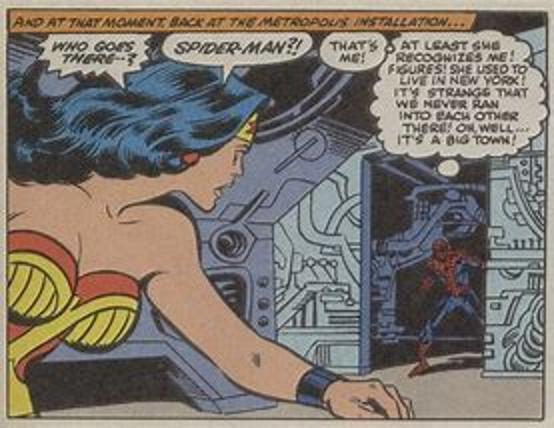
One thing that shows the limitations of superheroes is if there’s a crisis
they may show up or they may not.
“Are you having drinks after work?”
“Shut up, I’m on a roll.”
There are some instances with an interesting maturity in the story. Superman cannot drag Doom from the Latverian embassy or chase him into it because Superman will not break any laws and in Latveria, Doom is monarch. It’s a single issue, but you do have to wonder why the United States never attacks Latveria for all those one-man invasions.
There’s a good use of parallels in this story. Look at the differences between Superman versus the Hulk and Wonder Woman versus Spider-Man. How closely matched they are and what a difference a brain makes, good and bad.
Doom is planning to take away everyone’s electrical power. Generators won’t work. Except for his one and only really efficient generator, of course. People will make him dictator of the world to get energy back, though he could just sell it to them and with the money buy the world. Seriously, three or four step plan and he’d be there.
His generator requires some things like the Parasite to fight superheroes, get betrayed and be turned into a crystal and that crystal to…do stuff to keep the generator working.
In return for his mercenary services, Doom offers the Parasite power absorbed from Superman, Wonder Woman, Hulk, and Spider-Man. Parasite is fine with this, since he plans to turn on Doom later.
It comes to the big fight. Superman fights the Parasite and other unnamed canon fodder.
Parasite picks up some powers from Spider-Man and his new spider-sense tells him Doom is a danger. Duh. Their alliance falls apart.
“Having a drink after work?”
“No thanks, I think I’m stupid enough.”
Doom runs back to the Latverian embassy in an era when people hadn’t seen a refugee in an embassy surrounded by cops turning it into a prison. Oh, those simpler days.
Spider-Man’s spider-sense tells him how to turn off the generator. This is the first and last time I know of where Spider-man gets information this specific from his spider-sense. Does it work when he defuses a bomb? Chooses a slot machine? Still, it worked like that in the story.
So everything was solved and wrapped up for this time, but the Parasite wasn’t destroyed and Dr Doom wasn’t captured. Neither Superman nor Spider-Man could have won on their own. Indeed, they could not have succeeded as a team: Hulk and Wonder Woman were also essential.
The story was well tied up but Treasury Editions might have gone further. Marvel could have drawn a conclusion to the arc of the characters and finished off the two villains. After all, the story was never meant to be canon.
At the time it must have looked like Treasury Editions would be here to stay. That is not the nature of the comic book industry. Paper got pricier and new ideas had to be tried. They were, sometimes they worked, sometimes they didn’t. The idea of the big showcase returned with graphic novels. The Treasury Editions are not gone they just came back bigger and better. But a short graphic novel set in Treasury format, that might work again. It’s format was larger and in comic racks that didn’t work as well, in comic shops with display shelves the Treasury format might be a godsend.
“Getting a drink after work?”
“No, I’m going to read comic books.”
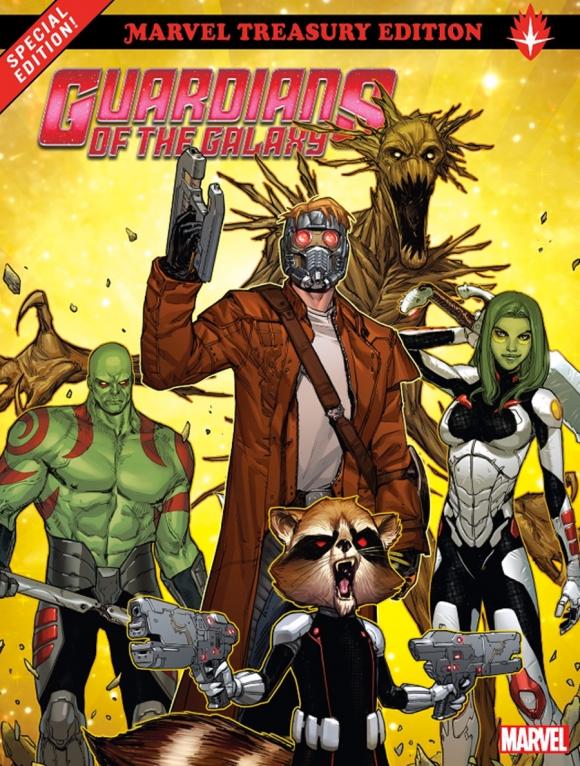
Start fans off with what the movie makes them expect
and put them in extra large magazines that are easy to find.
Maybe start with the new Treasury Edition Guardians of the Galaxy (published in 2016), because Marvel is trying the format again. The times will suit the format better.

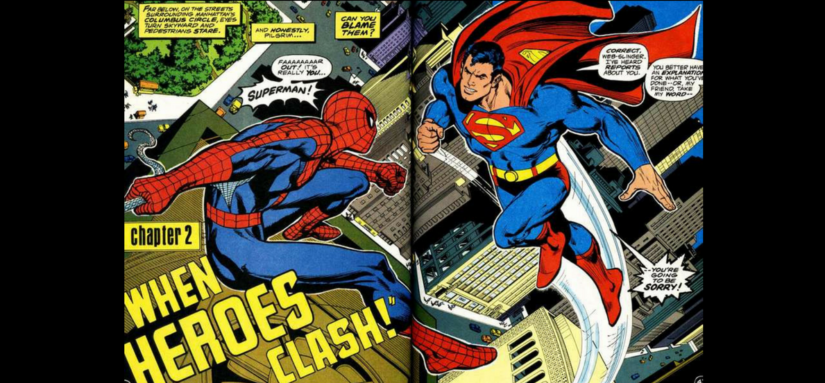
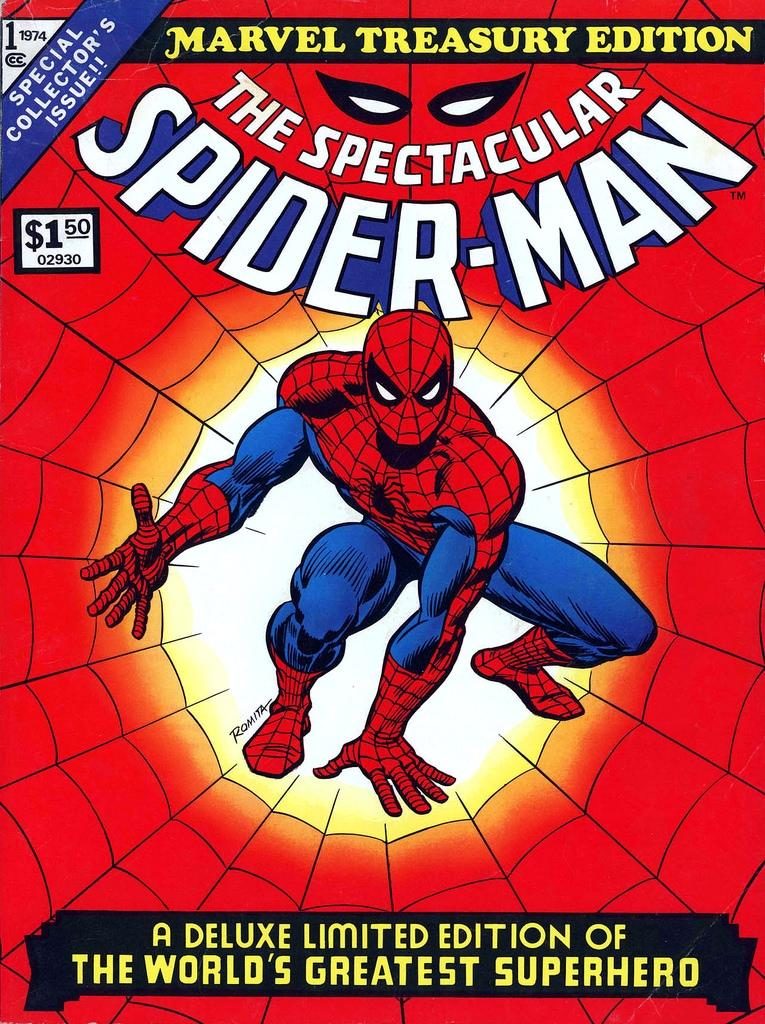



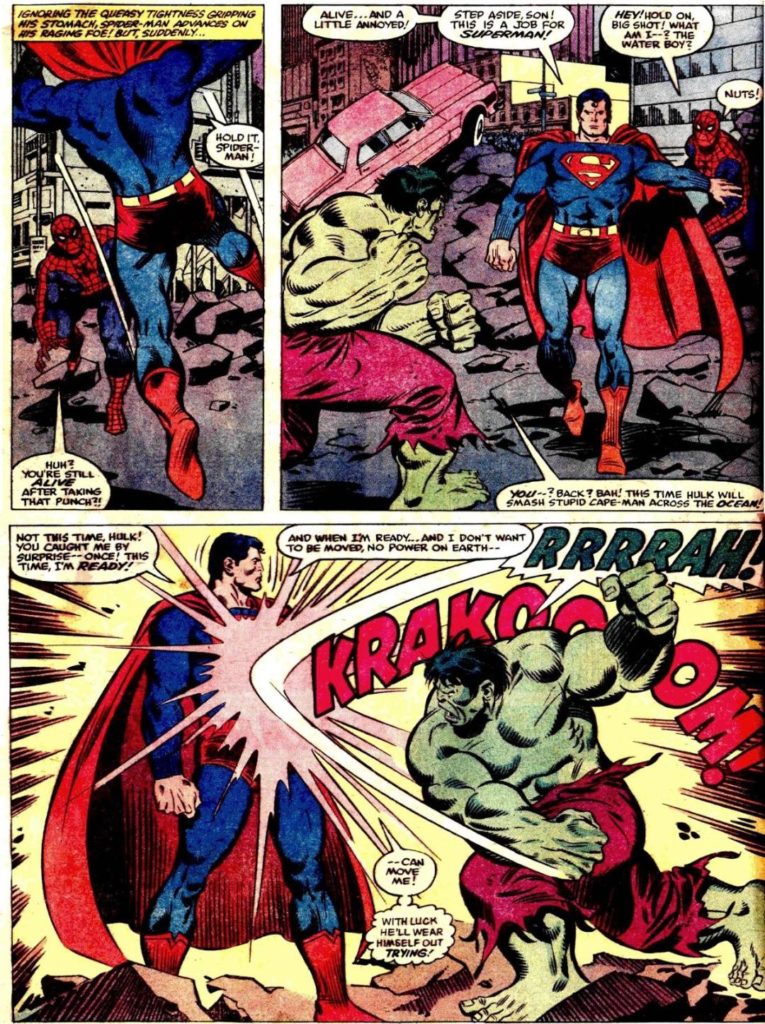
Comments are closed.